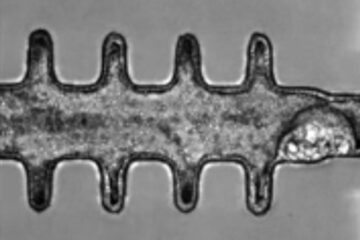New fruit fly protein illuminates circadian response to light

The body's 24-hour clock controls a multitude of internal functions such as periods of sleep and wakefulness, body temperature, and metabolism. Although circadian function produces a stable rhythm in the body, the biological clock will reset in response to light. The human condition known as jet lag takes place during the period when the body is attempting to resynchronize to the environmental light changes brought on by travel, namely from one time zone to another.
A mutant fruit fly that possesses jetlag-like behaviors enabled senior author Amita Sehgal, PhD, Professor of Neuroscience at Penn and a Howard Hughes Medical Institute (HHMI) Investigator, and colleagues to identify the gene and subsequent protein that aids in the response of the internal biological clock to light. The researchers report their findings in most recent issue of Science.
To test the circadian rhythm of fruit flies, Sehgal and others exposed wild type (control) and mutant flies to several light and dark settings – constant darkness, constant light, and equal periods of light and darkness (a light-dark cycle). During exposure to constant light for one week, the controls developed a disrupted sleep pattern after a few days, while the mutants maintained a regular circadian rhythm. The mutant and control flies displayed no behavioral differences during their exposure to constant darkness and the light-dark cycle. However, when the fruit flies were shifted from one light-dark cycle to another, the mutant flies took two days longer to adjust their sleep-wake cycle to the new light-dark schedule.
“The behavior of the mutant flies is similar to that displayed in a person who has prolonged jetlag,” notes Sehgal. In search of answers to the mutant's defective circadian response to light, Sehgal and colleagues looked to the molecular details of the clock cells in the jetlag flies.
When a fruit fly is exposed to light, a photoreceptor called cryptochrome (CRY) transduces the light signal and kicks off a series of reactions within the clock cells of the brain. Under normal conditions, CRY will respond to light by binding to a protein called timeless (TIM). A second protein, a member of the F-box protein family, also binds to TIM, signaling TIM for cellular destruction.
Genetic analysis revealed that the jetlag flies possess a mutation in a gene that encodes a member of the F-box protein family. A closer examination of the protein produced by the mutated sequence led researchers to JET, a new protein within the F-box protein family.
“Since the degradation of TIM always happens in the presence of light, the animal associates the absence of TIM with daytime hours,” explains Sehgal. The mutated JET protein reduces the light-dependent degradation of TIM and the circadian response to light.
Sehgal and others were able to reverse the behaviors in the jetlag flies by genetically replacing the mutated gene sequence with the normal sequence, which led to the production of the wild-type (control) JET protein. When the jetlag flies acquired the normal JET protein, regular TIM degradation took place and the fruit fly was better able to adjust to shifts in the light-dark cycle.
Future studies in the Sehgal lab will focus on continuing to identify other molecules required for the circadian response to light. “Some of the molecules required for the circadian light response in flies may be conserved in humans. Over time, we will have a better understanding of how the human clock responds to light and may be able to design drugs to treat jetlag,” concludes Sehgal.
Media Contact
More Information:
http://www.uphs.upenn.eduAll latest news from the category: Life Sciences and Chemistry
Articles and reports from the Life Sciences and chemistry area deal with applied and basic research into modern biology, chemistry and human medicine.
Valuable information can be found on a range of life sciences fields including bacteriology, biochemistry, bionics, bioinformatics, biophysics, biotechnology, genetics, geobotany, human biology, marine biology, microbiology, molecular biology, cellular biology, zoology, bioinorganic chemistry, microchemistry and environmental chemistry.
Newest articles

Solving the riddle of the sphingolipids in coronary artery disease
Weill Cornell Medicine investigators have uncovered a way to unleash in blood vessels the protective effects of a type of fat-related molecule known as a sphingolipid, suggesting a promising new…

Rocks with the oldest evidence yet of Earth’s magnetic field
The 3.7 billion-year-old rocks may extend the magnetic field’s age by 200 million years. Geologists at MIT and Oxford University have uncovered ancient rocks in Greenland that bear the oldest…

Mini-colons revolutionize colorectal cancer research
As our battle against cancer rages on, the quest for more sophisticated and realistic models to study tumor development has never been more critical. Until now, research has relied on…





















